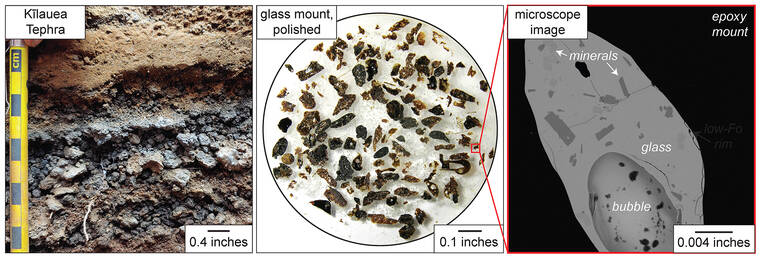Follow along as we outline the journey of one of our volcanic samples used for geochemical analysis and the information we glean at each step.
First, a geologist observes and describes a sample where it is found — a “rock description” is a basic but important first step in data collection. To do this, we answer several important questions: Is this a lava flow or a tephra (explosive) deposit?
If it is a lava flow, is it ‘a‘a or pahoehoe? Is the texture smooth and glassy or rough with many gas bubbles (vesicles)? What minerals can you see?
If it is a tephra deposit — are there different layers? How thick are the layers? What is each layer made of?
A photograph is taken to document what it looks like in place (don’t forget to add something for scale—this can be a common object like a coin or rock hammer, or a ruler with a real scale).
Next, samples of the material are collected if needed. HVO staff always collect samples with a sense of purpose and scientific need. Samples provide important additional information about eruptions, such as temperature or explosivity, that cannot easily be measured in the field. All sampling is done following established protocols and archived accordingly.
For lava flows, hand-sized chunks are unobtrusively picked up or gently broken off using a rock hammer. Tephra deposits generally require more care, to isolate specific layers and carefully scoop or scrape them into sample bags.
All sample bags are carefully labeled with important information. Who collected the sample? What is the date (and the time, if relevant)? What are the GPS coordinates of the sample location? If the lava was molten when collected, was it cooled in air or with water?
Samples are then brought to the lab where they may be split into multiple subsamples. Lava samples might be cut with a saw to make a thin section—a slice of polished rock thinner than a single strand of human hair—or crushed into a fine powder that is used to measure the composition.
Tephra samples are usually dried, weighed, and then separated into differently sized grains. Each size fraction can be used to study the componentry (what the samples are made of). Is the sample primarily made of millimeter (0.04 inches) sized pieces of fresh lava? Or fine-grained lithic material made of fragments of older and recycled rocks? Are any of the fragments minerals (green olivine, white plagioclase)?
Minerals and the freshest glassy part of the samples are the focus of geochemistry studies. Using a microscope and tweezers we pick out these fresh glassy pieces from size fractions that range from 0.5–2 millimeters (0.2–0.8 inches) or take glassy chips from lava flows. These fragments are then placed into a 2.5-centimeter (one-inch) round mold that is filled with epoxy glue. After the epoxy cures, we grind away the surface to expose the inside of the fragments and then polish the surface to make it flat, mirror-like, and reflective. Then the sample is ready for analysis!
The mounts are coated with a very thin layer of carbon to make the surface conductive. This allows the samples to be characterized via electron microscope or electron microprobe. Using these instruments, we can both see and chemically analyze very tiny minerals and textures in the samples (down to less than 1 micron, or 0.00004 inches).
The information gained at every step — from macro to micro scales—helps us understand how and why Hawaiian volcanoes erupt and to better assess future hazards.
Volcano Activity Updates
Kilauea volcano is erupting. Its USGS Volcano Alert level is at WATCH (https://www.usgs.gov/natural-hazards/volcano-hazards/about-alert-levels). Kilauea updates are issued daily.
Kilauea volcano is erupting. its USGS Volcano Alert level is at WATCH. Over the past week, lava has continued to intermittently erupt from the western vent within Halemaʻumaʻu crater. All lava is confined within Halemaʻumaʻu crater in Hawaii Volcanoes National Park. Sulfur dioxide emission rates remain elevated and were last measured at approximately 2,100 tonnes per day (t/d) on June 22. Seismicity is elevated but stable, with few earthquakes and ongoing volcanic tremor. Summit tiltmeters several minor deflation-inflation trends over the past week.
Mauna Loa is not erupting and remains at Volcano Alert Level ADVISORY. This past week, about 62 small-magnitude earthquakes were recorded below the summit and upper elevation flanks of Mauna Loa — the majority of these occurred at shallow depths less than 9 miles below sea level. GPS measurements show low rates of ground deformation over the past week. Gas concentrations and fumarole temperatures at both the summit and at Sulphur Cone on the Southwest Rift Zone have remained stable over the past week. Webcams show no changes to the landscape.
Seven earthquakes were reported felt in the Hawaiian Islands during the past week: a magnitude-3.4 earthquake 5 miles ENE of Pahala on June 19 at 6:09 p.m., a magnitude-2.9 earthquake 9 miles WNW of Kalaoa on June 19 at 12:36 p.m., a magnitude-2.5 earthquake 4 miles NE of Pahala on June 19 at 11:27 a.m., a magnitude-3.8 earthquake 5 miles E of Pahala on June 19 at 11:17 a.m., a magnitude-3.9 earthquake 5 miles ENE of Pahala on June 19 at 11:15 a.m., a magnitude-3.3 earthquake 2 miles SSW of Pahala on June 17 at 3:04 p.m., a magnitude-2.9 earthquake 4 miles E of Pahala on June 16 at 3:26 p.m.
Visit usgs.gov/observatories/hawaiian-volcano-observatory for past Volcano Watch articles, updates, photos, maps, recent earthquake info, and more. Email questions to askHVO@usgs.gov. Volcano Watch is a weekly article and activity update written by USGS Hawaiian Volcano Observatory scientists and affiliates.






